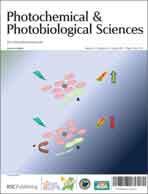Triplet-state dynamics of a metalloporphyrin photosensitiser (PtTMPyP4) in the presence of halides and purine mononucleotides†
Abstract
The photophysical properties of Pt(II) meso-tetrakis(4-N-methylpyridyl)porphyrin (PtTMPyP4) have been investigated in the presence of


 Please wait while we load your content...
Please wait while we load your content...